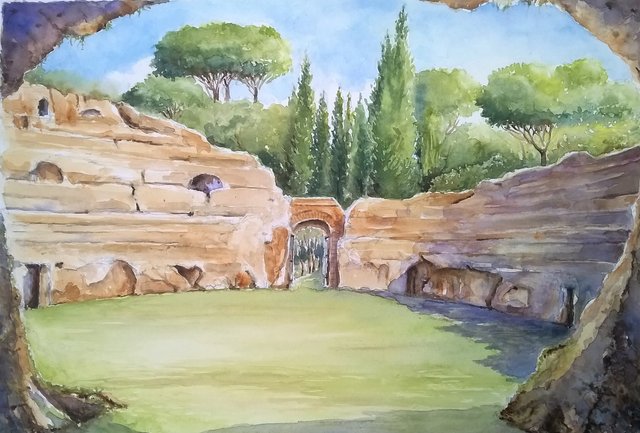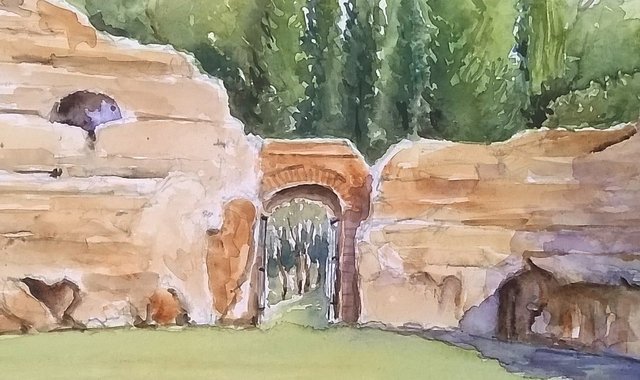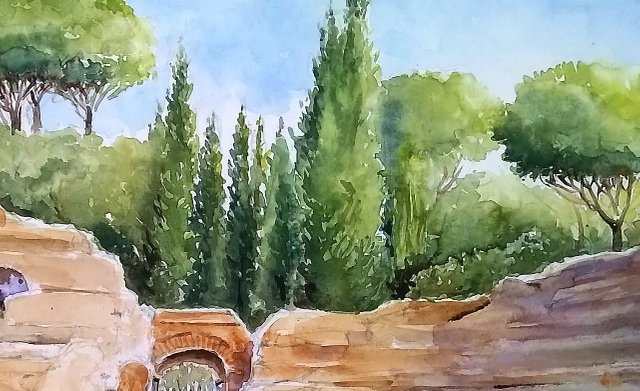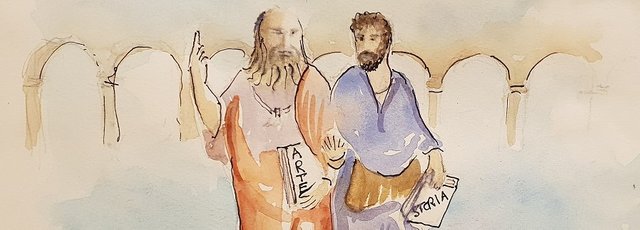i colori dell'anfiteatro __acquarello/// the colors of the amphitheater__watercolor

i colori dell'anfiteatro
the colors of the amphitheater

2 0 1 8
acquarello su carta


Anfiteatro o teatro?
amphitheater or theater?
Oggi condivido un acquarello dell'anfiteatro romano di Sutri, a 30 km da Roma, oggetto di una mia gita e ritratto in una bella giornata di sole.

Today I share a watercolor of the Roman amphitheater of Sutri, 30 km from Rome, object of my trip and portrayed on a beautiful sunny day.
Italiano:
Il Colosseo, l'Arena di Verona, Nimes in Francia, Pola in Croazia, Treviri in Germania, Al Khums in Libia, sono solo alcuni dei 230 grandi anfiteatri edificati dall'Impero Romano nelle varie aree geografiche in Europa e in Medio Oriente.
Molte persone fanno confusione nel distinguere un anfiteatro da un teatro antico, sia esso greco o romano.
Le differenze tra le due tipologie sono molto chiare, nella forma e nella destinazione o funzione di essi.
Nella forma: l'anfiteatro ha forma ellittica od ovale, è aperto, con gradinate per gli spettatori disposte intorno all'arena.
Essa era il luogo dove avvenivano gli spettacoli pubblici,di solito corse di carri o bighe tirate da cavalli, lotte e combattimenti tra gladiatori e tra uomini e belve.
Il termine "anfi" in greco significa sia "intorno" quindi con la possibilità di vedere nello spazio attorno alle manifestazioni nell'arena.
Il teatro ha forma semicircolare, la parte impegnata per le gradinate è chiamata cavea, e sul lato rettilineo presenta lo spazio scenico, al di sotto di esso, al centro, abbiamo l'orchestra, luogo usato per il coro o musicisti.
Il teatro al contrario dell'anfiteatro può essere coperto da un sistema architravato che poggia su colonne e capitelli, inoltre è singolare la disposizione dei teatri greci e in parte romani che sfruttano il declivio delle colline per inserire le gradinate, ed in Italia grazie alla sua varietà geomorfica abbiamo decine di teatri che usano questo sistema le cui strutture, spesso autoportanti venivano abbellite da marmi e fregi di grande eleganza.
L'anfiteatro era un vero e proprio luogo di divertimento per il popolo, che poteva schiamazzare, urlare e inveire a proprio piacimento. Veniva anche riempito d'acqua e destinato a battaglie navali ricostruite nei particolari con minuziosa perizia, talvolta in estate o in aree particolarmente calde l'anfiteatro poteva essere coperto da uno più teloni enormi.
l'anfiteatro era un edificio pubblico che veniva costruito in tutte le città di una certa importanza durante l'occupazione dell'Impero.
Il termine teatro dal greco théatron, che significa "spettacolo", e dal verbo "théaomai", ossia "vedo" è emblema della visione di un evento dal vivo.
Nasce dopo la narrazione orale, forse in Egitto, e si svilupperà in tutto il mondo antico.
Il teatro era il luogo dove venivano rappresentate le arti visive, danza, musica e soprattutto la commedia e la tragedia,quindi manifestazioni in cui prevaleva un senso culturale e ricco di contenuti umanistici.
Nella Grecia antica ebbe anche la funzione di far presentare dichiarazioni importanti, ad esempio di guerra, atti politici o di accusa.
Il teatro continuerà fino ad oggi la sua tradizione culturale, affiancato dall'anfiteatro che lascerà il posto agli stadi moderni per grandi manifestazioni e gare sportive.
Un abbraccio teatrale da Armando.

English

The Colosseum, the Arena of Verona, Nimes in France, Pula in Croatia, Trier in Germany, Al Khums in Libya, are just some of the 230 large amphitheaters built by the Roman Empire in the various geographical areas in Europe and the Middle East.
Many people are confused in distinguishing an amphitheater from an ancient theater, be it Greek or Roman.
The differences between the two types are very clear, in the form and in the destination or function of them.
In the form:
The amphitheater has an elliptical or oval shape, is open, with steps for spectators arranged around the arena.
It was the place where the public performances took place, usually the carriage of chariots or chariots pulled by horses, fights and fights between gladiators and between men and beasts.
The term "anfi" in Greek means "around" therefore with the possibility to see in the space around the events in the arena.
The theater has a semicircular shape, the part used for the steps is called cavea, and on the rectilinear side it presents the scenic space, below it, in the middle, we have the orchestra, used for the choir or musicians.
The theater, unlike the amphitheater, can be covered by an architraved system that rests on columns and capitals, and the arrangement of the Greek and partly Roman theaters that exploit the slope of the hills to enter the steps, and in Italy thanks to its geomorphic variety we have dozens of theaters that use this system whose structures, often self-supporting, were embellished by marbles and friezes of great elegance.
The amphitheater was a real place of entertainment for the people, who could shout, scream and rant at will. It was also filled with water and destined to naval battles reconstructed in detail with meticulous expertise, sometimes in summer or in particularly hot areas the amphitheater could be covered by one more huge tarpaulins.
the amphitheater was a public building that was built in all the cities of some importance during the occupation of the Empire.
The term theater from the Greek théatron, which means "show", and from the verb "théaomai", ie "I see" is emblem of the vision of a live event.
It arises after the oral narrative, perhaps in Egypt, and will develop throughout the ancient world.
The theater was the place where visual arts, dance, music and above all comedy and tragedy were represented, then manifestations in which a cultural sense prevailed and rich in humanistic content.
In ancient Greece it also had the function of presenting important statements, for example of war, political acts or accusations.
The theater will continue until today its cultural tradition, flanked by the amphitheater that will give way to modern stadiums for major events and sports competitions.
A theatrical hug from Armando.



detail

detail





discovery-it
https://steempeak.com/@discovery-it

Vieni a trovarci sulla prima rivista dedicata al mondo dell'arte&storia


It is an interesting angle where you showed the amphitheater in this picture. I like the colours that you use to paint this one, especially the purple shading :).
Hello @armandosodano, thank you for sharing this creative work! We just stopped by to say that you've been upvoted by the @creativecrypto magazine. The Creative Crypto is all about art on the blockchain and learning from creatives like you. Looking forward to crossing paths again soon. Steem on!
thank you very much @creativecrypto
Articolo sempre molto interessante. Pur conoscendo già di mio la differenza tra questi due termini, mi è piaciuto rileggere la sua spiegazione nella completezza di entrambi i termini.
Bellissimo anche l'acquerello, ovviamente!
Posted using Partiko Android
grazie Guido.
Beautiful painting of the amphitheatre, @armandosodano ! I love the perspective and the view that you've presented us with :) Very lovely!
Congratulations @armandosodano! You have completed the following achievement on the Steem blockchain and have been rewarded with new badge(s) :
Click here to view your Board of Honor
If you no longer want to receive notifications, reply to this comment with the word
STOPDo not miss the last post from @steemitboard: